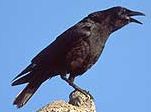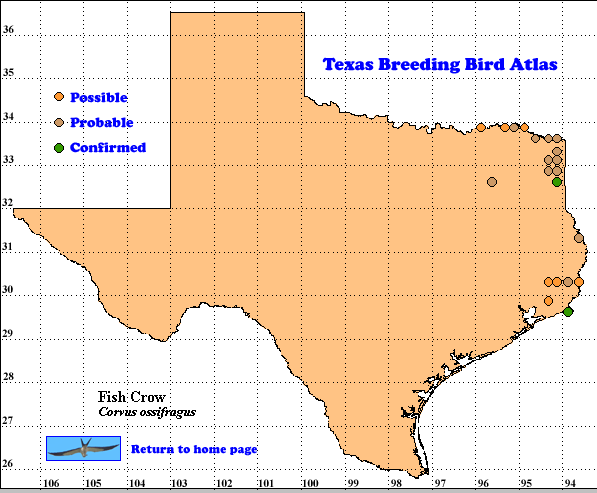Fish Crow, a poorly known member of its genus, resides on the Atlantic Coast and much of the Gulf Coast of the United States and far up some rivers (the Mississippi to St. Louis and the Arkansas to Kansas). While there are size differences among members of the genus Corvus found in Texas, voice is probably the best means of distinguishing them. Fish Crow has been described as an American Crow (Corvus brachyrhynchos) with a “bad cold.” (McGowan 2001).
DISTRIBUTION.During the 1987=1992 field work for the TBBA project volunteers found breeding evidence for Fish Crow along the Gulf Coast east of Houston, up the Sabine River and the Louisiana border to the Red River and west along it past the 95th meridian. Although only 4 of the 32 records were confirmed, many of the probable and possible records may represent actual breeding since this crow is present year-round and nest sites are frequently difficult to access (McGowan 2001). North American Breeding Bird Survey (BBS) volunteers found relative abundances of 1-3 Fish Crows per 40 km (25 mi) route (Sauer et al. 2005).
In other parts of the United States, Fish Crow is a permanent resident of the Atlantic and Gulf coasts and along low elevation stretches of rivers and streams from Maine to Louisiana and in parts of Arkansas, Oklahoma, Kansas, Missouri, Illinois, Kentucky and Tennessee (McGowan 2001, Sauer et al. 2005).
SEASONAL OCCURRENCE. The Fish Crow is a permanent resident in Texas, breeding occurs from March to June (Oberholser 1974, Lockwood and Freeman 2004).
BREEDING HABITAT. Fish Crows often breed in loose colonies, near fresh, brackish or salt water near beaches, swamps, marshes, rivers, large streams, lakes and even urban areas. Nests are often placed in the tops of tall trees 6-24 m (20-80 ft) above ground (Oberholser 1974, McGowan 2001).
The nest is built of sticks, twigs and bark fibers and lined with bark strips, grass, roots, hair and feathers. The outside diameter is 36-46 cm (14-18 in), height 25-36 cm (10-14 in), inside diameter 17-19 cm (6.5-7.5 in) and a cup depth of 13-15 cm (5-6 in).
The female usually lays 4-5 bluish or grayish green, slightly rough eggs (see Harrison [1979] for photo of markings). The eggs are indistinguishable from those of American Crow except for size. The female incubates the eggs for about 18-19 days. Young birds leave the nest about 21-30 days after hatching. Only 1 brood is raised per year (Harrison 1979, McGowan 2001).
STATUS. Lockwood and Freeman (2004) characterize Fish Crow as common along and near the Gulf Coast and uncommon in the northeast corner of the state. They note a range expansion in recent years west along the Red River consistent with the larger breeding aea shown on the TBBA map compared with Oberholser’s (1974) map.
BBS data from the 4 routes in Texas on which this crow was detected do not produce a meaningful trend. Results from 335 routes in the United States produce a 95% confidence interval (There is a 95% chance that the actual population trend will be between these two numbers.) of -0.3 to +1.9% for the period 1966-2004 (Sauer et al. 2005). The apparent lack of a range-wide negative trend is encouraging for the future of Fish Crow in Texas although hazards such as powerful storms and viral infections are always potential threats.
Text by Robert C. Tweit (2005)
Literature cited.
Harrison, H. H. 1979. A field guide to western birds’ nests. Houghton Mifflin, Boston, MA.
Lockwood, M. W. and B. Freeman. 2004. The TOS handbook of Texas birds. Texas A&M University Press, College Station.
McGowan, K. J. 2001. Fish Crow (Corvus ossifragus). In The birds of North America, No. 589 (A. Poole and F. Gill, eds.). The Birds of North America, Inc., Philadelphia, PA.
Oberholser, H. C. 1974. The bird life of Texas. University of Texas Press, Austin.
Sauer, J. R., J. E. Hines, and J. Fallon. 2005. The North American Breeding Bird Survey, results and analysis 1966-2004. Version 2005.1. USGS Patuxent Wildlife Research Center, Laurel MD (Web site, http://www.mbr-pwrc.usgs.gov/bbs).

